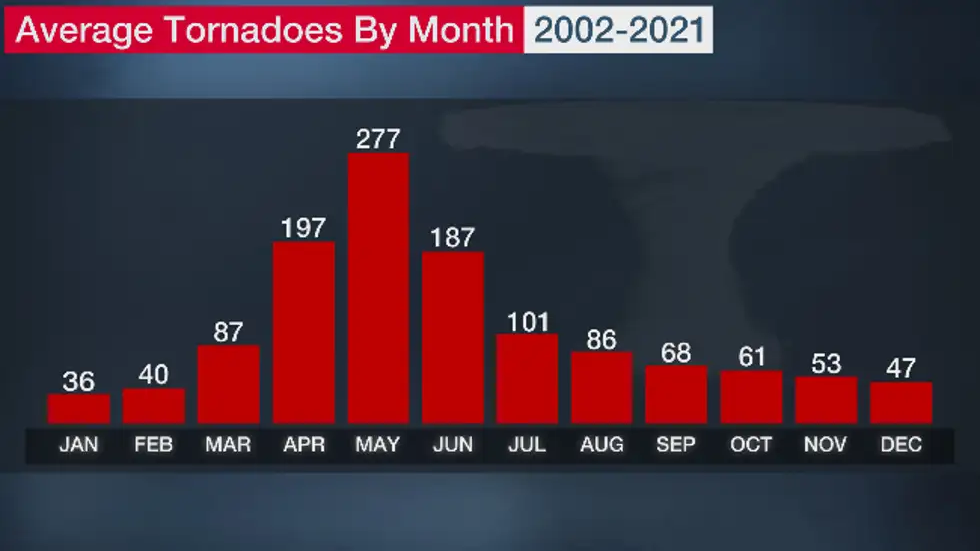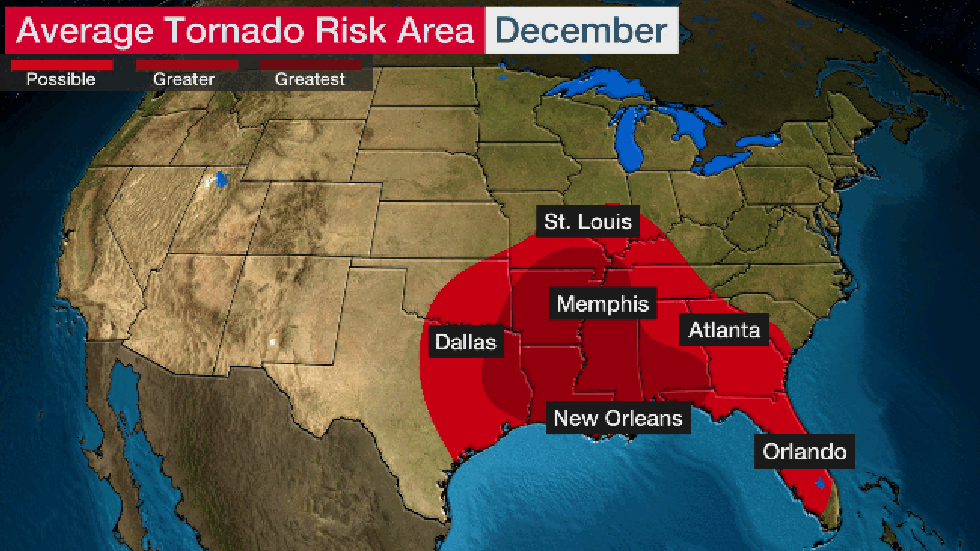Chris Dolce and Jonathan Erdman
Destructive tornadoes, even outbreaks, can occur in parts of the United States in December, January and February, despite winter's bone-chilling reputation.
That's certainly been the case recently, with three tornado outbreaks since mid-December, and five since early November.
The most recent outbreak on Jan. 12 included a destructive tornado in Selma, Alabama, and a deadly twister in Autauga County.
(MORE: Jan. 12 Outbreak News)
 Confirmed tornadoes and reports of tornadoes in five separate outbreaks from Nov. 4, 2022, through Jan. 12, 2023. (Note: Not all confirmed tornadoes may show up on this map, particularly on the Jan. 12, 2023, map which was created before many NWS damage surveys were completed.)
Confirmed tornadoes and reports of tornadoes in five separate outbreaks from Nov. 4, 2022, through Jan. 12, 2023. (Note: Not all confirmed tornadoes may show up on this map, particularly on the Jan. 12, 2023, map which was created before many NWS damage surveys were completed.)How This Happens In Winter
Severe thunderstorms and tornadoes need a mix of ingredients.
First, they typically need strong wind shear, a sharp change in wind speed and/or direction from the ground to the jet stream.
Since the jet stream is strongest in the U.S. in winter, this first ingredient is almost always sufficient. That was certainly the case on Jan. 12, when a 125-mph jet stream punched across the Deep South.
Then, you need it to be at least somewhat warm and humid. This is why severe thunderstorms in winter are relatively rare in the Northeast, Midwest or Northern Plains. It's just too cold.
If Arctic cold air dominates the country in winter, that shuts off the threat of severe thunderstorms everywhere.
But the Deep South isn't always cold in the winter. High temperatures can soar into the 60s, 70s or even low 80s, as happened during the Jan. 12 outbreak.
Its close proximity to the Gulf of Mexico means the Deep South can quickly become humid, fueling the instability needed to generate thunderstorms.
If that warm, humid air is in place ahead of a strong low-pressure system accompanied by a powerful jet stream, you get severe thunderstorms and tornadoes.

Tornadoes Are Typical, Even In Winter
While tornadoes in the U.S. are usually infrequent in winter, it is typical for at least some to touch down each season. Over the last 20 years, an average of 123 tornadoes have occurred in the U.S. from December through February.
However, that average masks a lot of variability. A December record 232 tornadoes tore through the U.S. in 2021, mainly from two large outbreaks in less than a week.
But some winter months only manage a handful of tornadoes, if that. February 2015 produced three tornadoes, and January 2014 only had four.
These winter tornadoes are often deadly. There's been at least one deadly winter tornado in the U.S. every year since 2005, according to data from NOAA's Storm Prediction Center.
Since 1991, only three years – 1992, 1994 and 2004 – didn't have a single deadly winter tornado.
 Average monthly tornadoes in the U.S., 2002-2021.
Average monthly tornadoes in the U.S., 2002-2021.Usually A Southern Thing In Winter
This probably isn't surprising, given the most recent outbreaks, but winter tornadoes favor a corridor of the South, especially the lower Mississippi Valley, Deep South and northern Gulf Coast.
Occasionally, some tornadoes can occur farther north into the Ohio or Mississippi valleys.
 Areas of typical risk for tornadoes in December, January and February.
Areas of typical risk for tornadoes in December, January and February.Prolific Winter Outbreaks
We mentioned the twin outbreaks in December 2021 earlier, but there have been many other notable rashes of tornadoes in January and February.
January's largest single outbreak happened over the course of two days when 129 tornadoes were spawned, mostly in the South, Jan. 21-22, 1999. Nine people died and 162 were injured in this outbreak.
February's largest outbreak was the so-called Super Tuesday outbreak of Feb. 5-6, 2008. A total of 86 tornadoes touched down in parts of 10 states, five of which were classified as "violent" EF4 tornadoes on the Enhanced Fujita Scale.
One of these EF4 tornadoes tracked an astonishing 122 miles across Arkansas, the longest tornado path on record in that state. Another EF4 tornado hit Jackson, Tennessee, inflicting damage on every building at Union University.
Ten killer tornadoes in this outbreak claimed a total of 57 lives, making it the deadliest tornado outbreak since May 31, 1985.
The Weather Company’s primary journalistic mission is to report on breaking weather news, the environment and the importance of science to our lives. This story does not necessarily represent the position of our parent company, IBM.
The Weather Company’s primary journalistic mission is to report on breaking weather news, the environment and the importance of science to our lives. This story does not necessarily represent the position of our parent company, IBM.

No comments:
Post a Comment